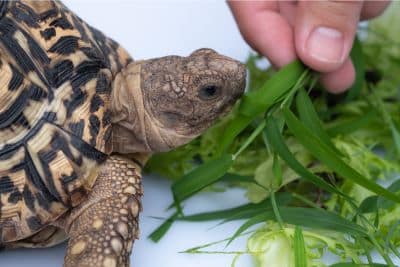I obviously love tortoises and think they make great companions, but there’s a lot you need to know before welcoming one into your home. Perhaps the most important thing to understand is that not all tortoises make good pets.
Some tortoises are simply too big to keep in an indoor enclosure. Others are native to climates far different than the average household and can’t adapt to the temperature or humidity found inside your home.
In this article, I share my views on the best tortoises for indoor pets and what you need to know to set up the perfect enclosure for your new reptile companion.
Things to Consider Before Getting a Tortoise
I can’t tell you which tortoise species is the best for you, but I can tell you what factors determine whether or not a tortoise will thrive indoors.
Size
Size really does matter when it comes to adopting a pet tortoise. Larger tortoises require exponentially more space to properly house. Once a tortoise gets to a certain size, it becomes nearly impossible to keep indoors without seriously impacting its happiness and health. That’s why many new keepers prefer to choose a tortoise species that stays small.
Many owners keep their larger tortoises outdoors in warmer climates. However, not all of us live in a climate where this is possible and/or have the garden space required to keep one of these gentle giants safely contained.
Climate Needs
Speaking of climate, tortoises are adapted to a variety of different habitats from around the world.
Those most capable of thriving indoors are typically native to semi-arid, moderately warm climates like the Mediterranean. In fact, most pet tortoise species belong to a group called the Mediterranean tortoises in the genus Testudo.
You can kind of think of a pet tortoise as a houseplant. Houseplants are popular because they can survive the temperature, humidity, and sunlight available in our homes—there’s a reason we don’t grow roses indoors. The same concept can be applied to tortoises!
Temperament
While each tortoise has its own personality and quirks, there are specific traits seen in some species more than others. Some species are extremely curious and will dig or climb wherever they can. The pancake tortoise is just one example.
More ‘adventurous’ tortoises can be harder to keep indoors unless you invest in an enclosure that meets their needs. (I’m not saying it’s impossible, but I also wouldn’t recommend one of these tortoises to a beginner!)
6 Best Tortoise for Indoor Pets
There are several tortoise species that can successfully live indoors. While a couple of these species are quite simple to care for, others have specific needs that might mean investing in a special enclosure.
Above all else, remember that every single one of these tortoises needs adequate space. Even the smallest species on this list, the Egyptian tortoise, does best in a large enclosure with plenty of room to move around.
1) Russian Tortoise (Testudo horsfieldii)
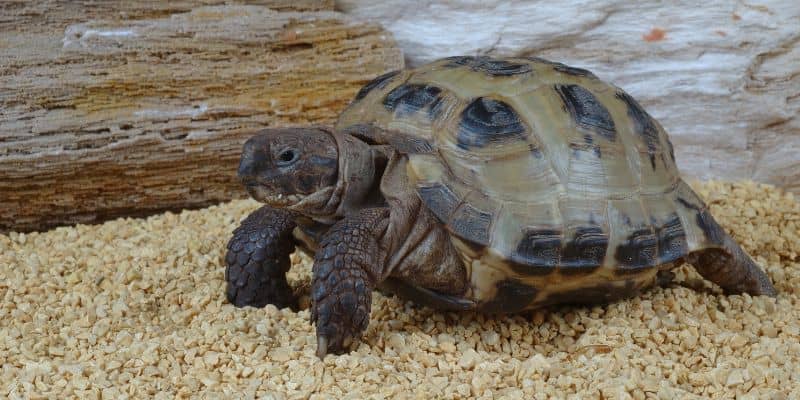
- Other names: Afghanistan tortoise, steppe tortoise, Horsfield’s tortoise, four-toed tortoise
- Conservation Status: Vulnerable
The Russian tortoise is one of the most popular pet tortoises for several good reasons. These small tortoises belong to the Mediterranean group and are used to surviving in warm, semi-arid climates with sandy or rocky terrains.
Your average Russian tortoise measures 6 to 10 inches long at maturity and weighs about 2 to 3 pounds. I definitely recommend at least considering a Russian as a pet if you plan to keep your tortoise indoors.
While hatchling Russians are often kept in large aquariums, a tortoise will quickly outgrow this space as it matures. The recommended enclosure for one of these pets is a wooden tortoise table measuring at least 4 feet long and wide (but ideally larger!). I also know of a few owners who have successfully housed their Russian tortoises in 50-gallon plastic containers, such as those designed for under-bed storage.
The bulk of your Russian’s enclosure should be between 70 and 80°F. The space directly beneath its heat lamp should reach 95°F during the day. Add a couple of hiding spots for your tortoise—I like to include one on the cooler end of the enclosure and another on the warmer end.
Russian tortoises make excellent house pets in part because they like drier environments. The enclosure should be around 50% humidity, which is normal for most home interiors.
Are You Starving Your Tortoise?
Save 10% on premium tortoise food and supplements from Tortoise Resource Center on Amazon now using code BUYNOWGET10
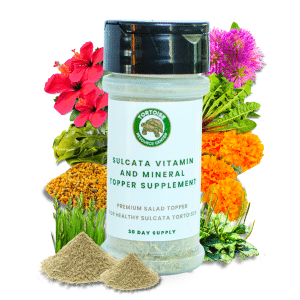
Sulcata Vitamin & Mineral Topper Supplement
30-Day Supply | 2 oz (56 g)
$24.99
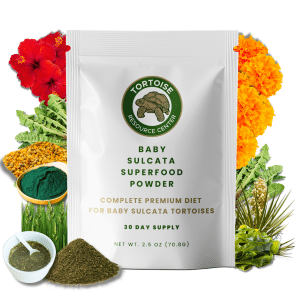
Baby Sulcata Tortoise Superfood Powder
30-Day Supply | 2.5 oz (70.8 g) Bag
$24.99
2) Hermann’s Tortoise (Testudo hermanni)
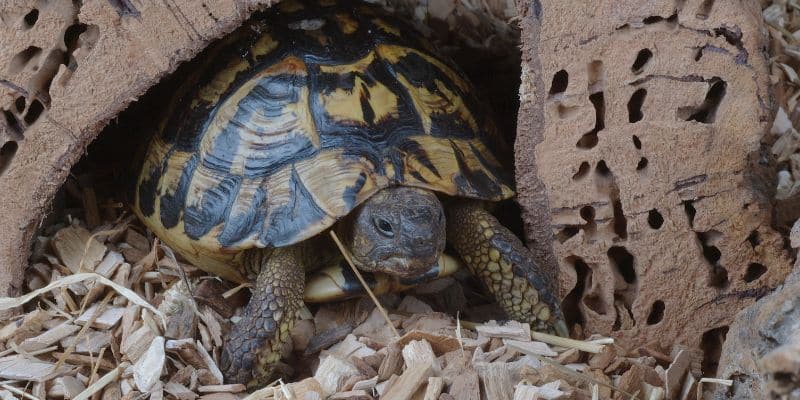
- Other names: Dalmatian tortoise
- Conservation Status: Near threatened
Hermann’s tortoises are close relatives of the Russian tortoise and even grow to a similar size. You’ll want an equally large enclosure like those I described in the previous section—i.e., a wooden tortoise table measuring at least 4 feet in length and width.
The Hermann’s tortoise has a reputation for being difficult to keep indoors. While there is a learning curve involved, I find that their care is very similar to that of the Russian tortoise. The most important thing to remember is that they need space to freely roam and burrow.
If possible, consider keeping your Hermann’s tortoise indoors only during the cooler months (this, of course, depends on your local climate). Hermann’s tortoises seem to thrive when given the freedom to explore multiple habitats, so maintaining two separate enclosures works best for their personality.
3) Egyptian Tortoise (Testudo kleinmanni)
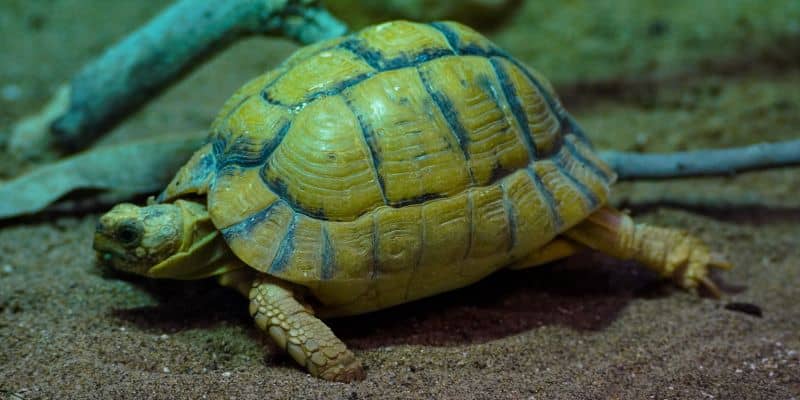
- Other names: Kleinmann’s tortoise, Leith’s tortoise, Negev tortoise
- Conservation status: Critically endangered
Egyptian tortoises are the smallest species commonly seen in the pet trade, measuring 4 to 6 inches long at most. Unfortunately, this species is also very hard to find from an ethical source. Adopting an Egyptian tortoise usually means sitting on a breeder’s waitlist for several months or longer.
The Egyptian tortoise is one of the only species that, at least in my experience, can happily live in small groups. It’s pretty common for people to keep two or more of these tortoises in one enclosure. Just keep in mind that mature male Egyptian tortoises will get semi-aggressive around mating time and may need to be temporarily separated.
If you want to keep more than one tortoise together, you’ll need to account for the extra headcount with more space. I recommend 21 square feet for up to 2 adult Egyptian tortoises and an additional 5 square feet for every tortoise after that.
4) Indian Star Tortoise (Geochelone elegans)
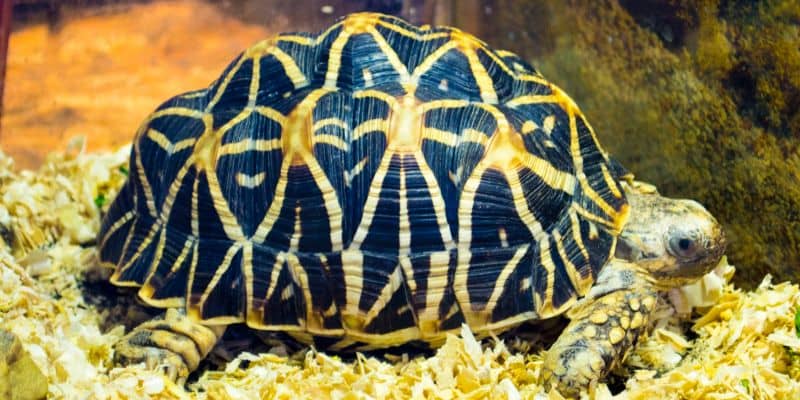
- Other names: Star tortoise
- Conservation status: Vulnerable
The Indian star tortoise definitely stands out with its decorative patterned shell and stark coloring. It is also one of the only small pet tortoises not belonging to the Testudo genus.
You can keep an Indian star tortoise in most enclosures suitable for a Russian tortoise. Both species are similar in size and require the same amount of space, i.e. a minimum enclosure space measuring 16 square feet.
The enclosure should be a bit warmer than with other species, averaging 80°F with a basking spot up to 100°F. Indian star tortoises also need higher humidity. Consider adding a cover to your enclosure to keep heat and humidity inside.
Though it’s possible to keep an Indian star tortoise indoors year-round, they do have fairly specific climate requirements that can be hard to replicate indoors. Also they seem to prefer life in the great outdoors.
Personally, I only recommend keeping one of these tortoises as a house pet if you are already very experienced with tortoise care.
5) Greek Tortoise (Testudo graeca)

- Other names: Moorish tortoise, spur-thighed tortoise
- Conservation Status: Vulnerable
The Greek tortoise is nearly identical to the more common Hermann’s tortoise in both size and appearance. Unsurprisingly, they also require the same type of housing to thrive.
Greek tortoises are known for having friendly, curious personalities, making them popular as house pets. Despite this, you should limit any handling to only what’s absolutely necessary. Excess handling will stress your little tortoise no matter how gentle you are.
Another thing to know about these tortoises is that they have extremely long lifespans. Adopting a Greek tortoise means committing to several decades of care.
6) Pancake Tortoise (Malacochersus tornieri)
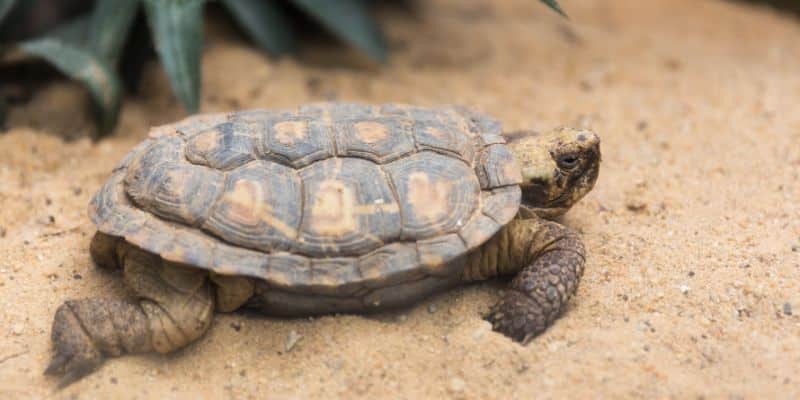
- Other names: Tornier’s tortoise
- Conservation status: Critically endangered
This unique little tortoise isn’t as common as most others on this list, but it is definitely possible to keep a pancake tortoise as a house pet.
As the name suggests, pancake tortoises are naturally flat. This shape lets them scurry between rocks in their natural environment. Pancake tortoises spend most of their time hiding in the shade among said rocks.
The pancake tortoise is relatively small, measuring just 6 or 7 inches long on average. A mature tortoise should be housed in an enclosure that measures at least 4 feet long and wide. These tortoises are surprisingly adept climbers, so the sides of the enclosure should be at least 24 inches tall.
Like other tortoises, these guys enjoy basking under a heat lamp during the day. However, pancake tortoises are more prone to overheating than other species, so be sure that they can escape to a cooler area as they please.
Types of Indoor Tortoise Enclosures
Tortoises—even small ones—need a lot of room to roam around, burrow, and do other tortoise things. (Since you’ve gotten this far, I hope you already know that you can’t drop a tortoise in a small glass aquarium and call it a day!)
Here are the most common types of enclosures used for pet tortoises kept indoors.
Tortoise Table
Tortoise tables are the most popular—and most highly recommended—enclosures for small indoor pets. They are usually made of wood and can be elevated (like a table) or kept on the ground.
Tortoise tables vary in size to accommodate all kinds of small tortoises. While some owners purchase ready-made tables such as the Geguri Tortoise Habitat, DIY setups are also incredibly common.
This type of enclosure is traditionally open-topped. However, mesh covers can also be used if you need to keep children or other pets away from your tortoise.
Plastic Tub
Some owners keep their tortoises in repurposed plastic enclosures made from things like kids’ swimming pools or storage tubs.
I personally wouldn’t use an enclosure like this for long-term housing. However, it’s a simple, affordable solution for young tortoises that are still growing or when transitioning to a more permanent enclosure.
You might also want to keep a smaller plastic enclosure on hand for any time when you need to remove your tortoise from its normal home (e.g., cleaning the enclosure).
Entire Room
If you have the living space to spare, you could even give your tortoise an entire room to call its own. This is most common with slightly bigger species that would require an extremely large tortoise table to be comfortable.
Of course, you’ll need to tortoise-proof the room and install things like a waterproof barrier and suitable substrate. This is a long-term investment but 100% worth it in the right situation!
Housing a Tortoise Indoors
This section covers the basics of indoor tortoise enclosures and what you’ll need to set your tortoise up for success. With that said, I highly recommend thinking about the space you have available both now and in the long term before investing in your own enclosure.
Square Footage
If you’re new to tortoise ownership, I can say with pretty great confidence that space is going to be the biggest limiting factor in housing your pet.
As a rule, a tortoise needs an enclosure that is at least 6 times bigger than itself. For example, the average Russian tortoise needs an enclosure that measures 5-by-5 feet. This is the bare minimum, though, and I always recommend providing more room if at all possible.
The amount of space required is what makes smaller tortoise species so much better for keeping indoors than their larger brethren.
Location
Place your tortoise enclosure in a quiet spot with natural light (but out of bright, direct sunlight). Check the area for cold air coming from nearby windows or HVAC vents—you’ll want to cover any drafts you do find.
Your tortoise will be happiest living somewhere with minimal noise and foot traffic. It’s important to set up the enclosure away from other pets or curious children who might disturb the tortoise.
I also recommend placing the enclosure in a spot where it won’t need to be disturbed very often. For example, I wouldn’t place your tortoise in front of a closet door. Your tortoise will be happiest when its enclosure is left alone.
Heat and Humidity
An indoor tortoise enclosure needs a quality heat source. You will need to install a heat lamp such as the Omayey 100W Ceramic Heat Lamp on one end of the enclosure so that your tortoise can move in and out of the heat as it pleases. You don’t want the entire enclosure to heat up (but the ‘cold’ side shouldn’t be much cooler than 68°F for most species).
Using a heat lamp also means investing in a good thermometer. Monitor the temperature directly below the lamp at the height where your tortoise’s shell will sit. It needs to be at least 12 inches above your tortoise, as a lamp that is mounted too low can burn or dry out the top of a tortoise shell.
Humidity is definitely something you’ll want to think about, as well, but needs vary greatly from one species of tortoise to another. Species that like a bit more humidity can benefit from daily misting or a semi-covered enclosure that traps in extra moisture.
I like this Reptile Thermometer Hygrometer as it provides accurate temperature and humidity readings. As a responsible keeper, you’ll want to get into the habit of checking the heat and humidity levels in your tortoise’s enclosure daily. Any fluctuations in the outside environment will have a knock-on effect indoors and you may need to increase or decrease those levels accordingly.
Light
Tortoises rely on sunlight to produce vitamin D. When keeping a tortoise indoors, you need to supplement this natural light with a UVA/UVB bulb turned on for about 12 hours a day. (Get yourself an automatic timer so you don’t need to remember to turn the lights on and off each day!)
Substrate
There are lots of different substrates you can use when housing a tortoise indoors. Popular options include coconut coir, soil, sand, sphagnum moss, and even shredded paper.
Any substrate used in your tortoise enclosure needs to be clean, chemical-free, and heat-treated to kill off pathogens. I highly recommend purchasing substrate from a reptile supplier rather than using something found at your local garden or hardware store.
I also recommend installing a waterproof layer below your tortoise substrate, especially if the enclosure floor itself is not waterproof.
Which tortoise species is the easiest to care for?
Small Mediterranean tortoises like the Russian or Greek tortoise are highly recommended for beginners. These species need less space than other species and are adaptable to average household conditions. Remember, though, that all tortoises require daily care from their owners just like any other pet.
If you enjoyed reading about small tortoise species, here’s a link to an article all about the small and rare Spider Tortoise.
Citations
- Horsefield Tortoise The Testudo tortoise
- Tortoise Trust Promoting proper bone development


